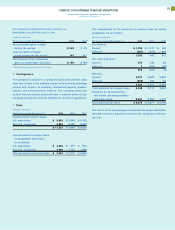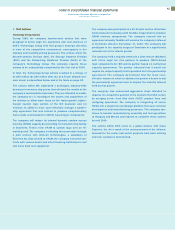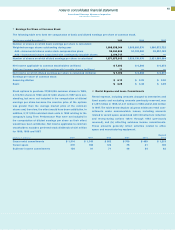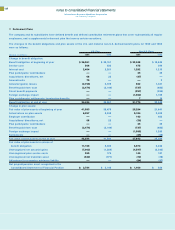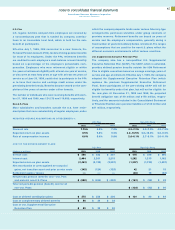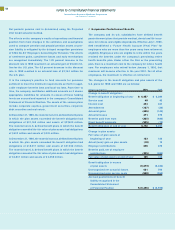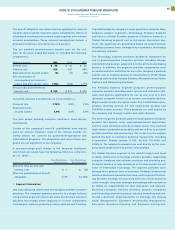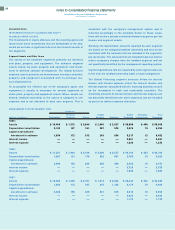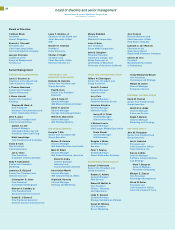IBM 1999 Annual Report Download - page 90
Download and view the complete annual report
Please find page 90 of the 1999 IBM annual report below. You can navigate through the pages in the report by either clicking on the pages listed below, or by using the keyword search tool below to find specific information within the annual report.
notes to consolidated financial statements
International Business Machines Corporation
and Subsidiary Companies
Net periodic pension cost is determined using the Projected
Unit Credit actuarial method.
The effects on the company’s results of operations and financial
position from most changes in the estimates and assumptions
used to compute pension and prepaid pension assets or pen-
sion liability is mitigated by the delayed recognition provisions
of SFAS No. 87, “Employers’ Accounting for Pensions.” The effects
of settlement gains, curtailment losses and early terminations
are recognized immediately. The 1.25 percent increase in the
discount rate in 1999 resulted in an actuarial gain of $5,003 mil-
lion for the U.S. plan. The 0.5 percent decrease in the discount
rate in 1998 resulted in an actuarial loss of $2,144 million for
the U.S. plan.
It is the company’s practice to fund amounts for pensions
sufficient to meet the minimum requirements set forth in appli-
cable employee benefits laws and local tax laws. From time to
time, the company contributes additional amounts as it deems
appropriate. Liabilities for amounts in excess of these funding
levels are accrued and reported in the company’s Consolidated
Statement of Financial Position. The assets of the various plans
include corporate equities, government securities, corporate
debt securities and real estate.
At December 31, 1999, the material non-U.S. defined benefit plans
in which the plan assets exceeded the benefit obligation had
obligations of $21,168 million and assets of $27,400 million.
The material non-U.S. defined benefit plans in which the benefit
obligation exceeded the fair value of plan assets had obligations
of $602 million and assets of $443 million.
At December 31, 1998, the material non-U.S. defined benefit plans
in which the plan assets exceeded the benefit obligation had
obligations of $18,217 million and assets of $21,736 million.
The material non-U.S. defined benefit plans in which the benefit
obligation exceeded the fair value of plan assets had obligations
of $3,831 million and assets of $3,558 million.
X Nonpension Postretirement Benefits
The company and its U.S. subsidiaries have defined benefit
postretirement plans that provide medical, dental and life insur-
ance for retirees and eligible dependents. Effective July 1, 1999,
IBM established a “Future Health Account (FHA) Plan” for
employees who are more than five years away from retirement
eligibility. Employees who are eligible to retire within five years
retained the benefits under the company’s preexisting retiree
health benefits plan. Under either the FHA or the preexisting
plan, there is a maximum cost to the company for retiree health
care. For employees who retired before January 1, 1992, that
maximum will become effective in the year 2001. For all other
employees, the maximum is effective on retirement.
The changes in the benefit obligation and plan assets of the
U.S. plans for 1999 and 1998 are as follows:
(Dollars in millions) 1999 1998
Change in benefit obligation:
Benefit obligation at beginning of year $««6,457 $««6,384
Service cost 48 42
Interest cost 424 427
Amendments (127) (26)
Actuarial gains (445) (146)
Actuarial losses 371 272
Benefits paid from trust (325) (486)
Direct benefit payments (225) (10)
Benefit obligation at end of year 6,178 6,457
Change in plan assets:
Fair value of plan assets at
beginning of year 123 120
Actual (loss)/ gain on plan assets (18) 10
Employer contributions 325 479
Benefits paid, net of employee
contributions (325) (486)
Fair value of plan assets at end of year 105 123
Benefit obligation in excess
of plan assets (6,073) (6,334)
Unrecognized net actuarial losses 631 700
Unrecognized prior service costs (948) (965)
Accrued postretirement benefit
liability recognized in the
Consolidated Statement
of Financial Position $«(6,390) $«(6,599)
88



